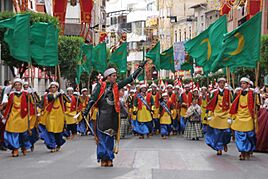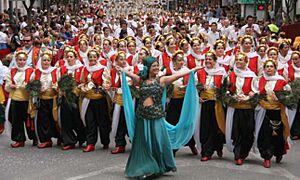Villena facts for kids
Quick facts for kids
Villena
|
|||
|---|---|---|---|
|
City
|
|||
|
Aerial view of Villena
Archpriestal St. James Church
Chapí Theatre at Paseo Chapí
Municipal Palace (City Hall)
Moors and Christians Festival
|
|||
|
|||
| Motto(s):
Villena ¡un tesoro!
|
|||
| Country | |||
| Autonomous Community | |||
| Province | Alicante | ||
| Comarca | Alto Vinalopó | ||
| Populated places |
16 populated places
Villena
Casas de Menor Casas de Cabanes y las Fuentes Casas de Jordán Cascante El Morrón Las Chozas La Gloria La Encina La Puentecilla Las Tiesas Las Virtudes La Zafra San Bernabé Santa Eulalia Sierra de Salinas |
||
| Area | |||
| • Total | 345.6 km2 (133.4 sq mi) | ||
| Elevation | 505 m (1,657 ft) | ||
| Population
(2018)
|
|||
| • Total | 33,983 | ||
| • Density | 98.330/km2 (254.67/sq mi) | ||
| Time zone | UTC+1 (CET) | ||
| • Summer (DST) | UTC+2 (CEST) | ||
| Postal code |
03400
|
||
Villena is a city in Spain, located in the Valencian Community. It's in the northwest part of Alicante province. Villena shares borders with Castilla-La Mancha and Murcia to the west. To the north, it borders the province of Valencia. To the east and south, it borders the rest of Alicante province.
Villena is the main city of the comarca (a type of region) called Alto Vinalopó. The city covers an area of 345.6 square kilometers. As of 2023, about 34,144 people live there.
People have lived in this area since the Middle Paleolithic period (a very long time ago!). The city itself existed by the 11th century, during the time of al-Andalus (Muslim rule). After the Reconquista (Christian conquest), Villena became an important area ruled by different lords. In 1525, Charles V officially made Villena a "City." This was a very successful time for Villena, and many old buildings from this period still stand today.
Even though a railway station opened in 1858, Villena's economy mostly relied on farming until the 1960s. Then, many people moved from farms to cities. Now, Villena's economy is mainly based on services and industries. These include making footwear (shoes), construction, and furniture.
Villena has many historical sites, including two castles, churches, and museums. The Archaeological Museum "José María Soler" is especially famous. The city also hosts exciting events like the Moors and Christians festival.
Contents
- What's in a Name? The Origin of "Villena"
- Symbols of Villena: The City's Coat of Arms
- Where is Villena? Its Geography
- Villena's Past: A Look at History
- Places to See in Villena
- Exciting Events in Villena
- Villena's Economy: How the City Works
- Sports in Villena
- Getting Around: Transport in Villena
- Famous People from Villena
- Sister Cities
- See also
What's in a Name? The Origin of "Villena"
The first known name for this area was Ad Turres. This name appeared on old Roman maps and likely referred to a Roman stopping point or villa. It was located somewhere between Villena and Font de la Figuera.
The name Villena has an interesting history. Some experts believe it comes from a Roman name like Belliana. This would be similar to how other Spanish towns got their names. However, there are some difficulties with this idea.
Another idea is that the name comes from the Arabic word Bilyāna. This Arabic name means "the filled (by Allah)." This name was used from the 11th century onwards. After the Christian conquest, the name changed a bit. It became Belliena in some old writings. Later, it changed to Billena because many of the conquerors were from Aragon. The spelling Villena became common around the 15th century. This happened because the Spanish language no longer clearly separated the 'b' and 'v' sounds. Also, the name sounded like the Spanish word villa, which means "town."
Symbols of Villena: The City's Coat of Arms
Villena's coat of arms (its official symbol) has been used for a long time, since at least 1477. However, it has never been officially approved by the government.
Let's look at what the symbols mean:
- The castle on the top left comes from the symbol of the Crown of Castile.
- The lion on the top right and the winged hand on the bottom left are symbols from don Juan Manuel. He was an important lord of the city a long time ago.
- The three pine trees and the pond on the bottom right represent the old Lagoon of Villena and the Fuente del Chopo. These were important natural resources for the city. The lagoon provided salt, and the spring provided fresh water.
- The crown at the top of the shield shows that Villena was once a marquisate.
Because the coat of arms isn't officially approved, you might see slightly different versions. Sometimes, the lion and winged hand sections are swapped!
Where is Villena? Its Geography
Villena is located in the northwest part of the province of Alicante. It's in a region called Alto Vinalopó. The city is in a very important spot, acting as a natural pathway. This pathway connects the Valencian Community, the Region of Murcia, and Castile-La Mancha. It's often called Villena's Corridor or Vinalopó's Corridor. This is because the Vinalopó river flows through Villena's land.
This corridor has been very important for travel and trade since ancient times. It was where the Roman road Via Augusta first entered the central plains of Spain. Being in the middle of towns like Biar, Sax, Font de la Figuera, Yecla, and Caudete made Villena a key place for transportation. Villena's area is 345.6 square kilometers, making it the second largest municipality in Alicante province.
Villena's Past: A Look at History
Villena's region was very important during the Bronze Age. This was a time when people started using metal. The area also played a role in developing early ways to work with metals.
Ancient Settlements and Discoveries
Cabezo Redondo is a very important archaeological site. It's on a hill about 2 kilometers from Villena. This was a busy center between 1500 and 1100 BC. It was likely part of the Argaric culture, an ancient civilization.
After the Islamic conquest of the Iberian Peninsula (when Muslims took control of Spain), the city was called Medina Bilyana. It was one of seven cities mentioned in an important agreement called the Treaty of Orihuela. Later, Christian knights from Calatrava conquered the city under King James I of Aragon. This caused some disagreements between the kingdoms of Castile and Aragon. Villena was supposed to belong to Castile based on earlier treaties. So, new agreements had to be signed, like the Treaty of Almizra.
After the Christian conquest, Villena became the capital of a very important area. It was ruled by different lords and changed titles many times, from a seigneury to a marquisate. Eventually, the people of Villena, encouraged by the Catholic Monarchs, rebelled against the marquis.
Amazing Gold Treasures
The Cabezo Redondo gold hoard was an exciting discovery. It was found by the Spanish archaeologist José María Soler García in 1959. This treasure includes 35 pieces of jewelry, like a tiara, rings, bracelets, and pendants.
Even bigger was the Treasure of Villena. This was also found near Villena in 1963 by José María Soler García. It's the most important ancient treasure found in the Iberian Peninsula. It's also the second largest in Europe, only smaller than the treasures from the Royal Graves in Mycenae, Greece.
This huge treasure wasn't found at Cabezo Redondo itself. It was found about 5 kilometers east of Villena. However, experts believe the people who lived at Cabezo Redondo buried it because the items are very similar to the Cabezo Redondo hoard.
Places to See in Villena
Villena has many interesting places to visit:
- Castle of la Atalaya: This castle was built by the Moors in the 11th century.
- Municipal Palace: This is the city hall building.
- Saint James Church: A beautiful Gothic Catholic church.
- Archaeological Museum: This museum was founded by archaeologist José María Soler García. It is home to the famous Treasure of Villena.
Exciting Events in Villena
Villena is famous for its Moros y Cristianos (Moors and Christians) festival. It's one of the biggest and most popular festivals of its kind in Spain!
The city also hosts Leyendas del Rock. This is one of the largest rock and heavy metal music festivals in Spain. It takes place every August.
Villena's Economy: How the City Works
The city's economy mainly relies on a few key industries. These include making footwear (shoes), similar to nearby cities like Elda and Novelda. Other important industries are pottery, furniture making, and wine production.
Sports in Villena
Villena is known for its connection to tennis. Juan Carlos Ferrero, a former world number one tennis player, created the Ferrero Tennis Academy here. This academy has helped train famous players like Guillermo García-López and Carlos Alcaraz.
Getting Around: Transport in Villena
Villena is easy to reach by road, as it's close to the Autovía A-31 highway. The city also has two railway stations. The Villena AV station serves AVE high-speed rail services. The other station, Villena, is for local and regional trains run by Renfe.
Famous People from Villena
Many notable people have come from Villena:
- Ambrosio Cotes: A composer from the Renaissance period.
- José García Hidalgo: A Baroque painter.
- Joaquín María López: A former Prime Minister of Spain.
- José María Soler: A famous archaeologist.
- Ruperto Chapí: A composer known for zarzuela music.
- Juan Carlos Ferrero: A professional tennis player.
- Pablo Menor: A Jesuit priest.
- Antonio Navarro Santafé: A sculptor.
- Carlos Alcaraz: A professional tennis player.
Sister Cities
Villena has two sister cities:
 Escalona, Spain: They became sister cities in 1982. This was to celebrate 700 years since the birth of don Juan Manuel, who was a lord of both Villena and Escalona.
Escalona, Spain: They became sister cities in 1982. This was to celebrate 700 years since the birth of don Juan Manuel, who was a lord of both Villena and Escalona. Peñafiel, Spain: Also became a sister city in 1982 for the same reason, celebrating don Juan Manuel.
Peñafiel, Spain: Also became a sister city in 1982 for the same reason, celebrating don Juan Manuel.
See also
 In Spanish: Villena para niños
In Spanish: Villena para niños
















